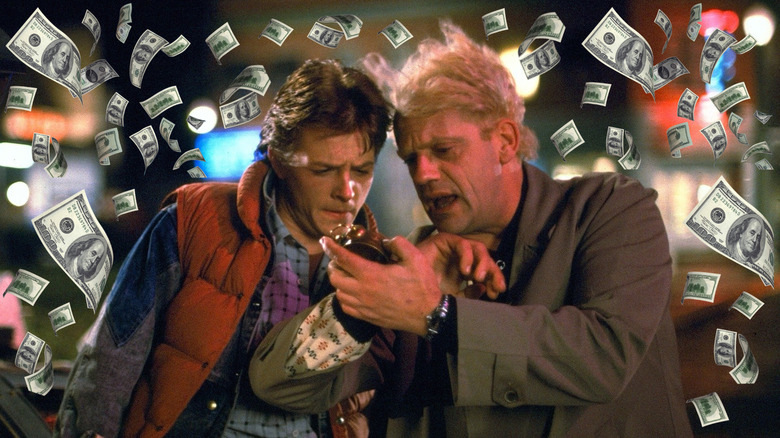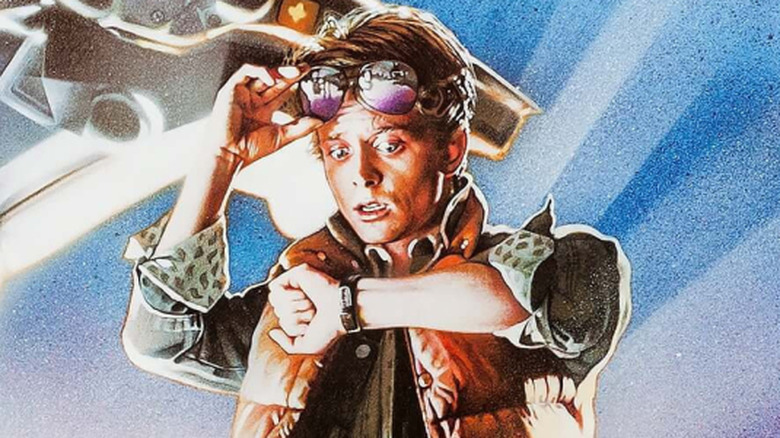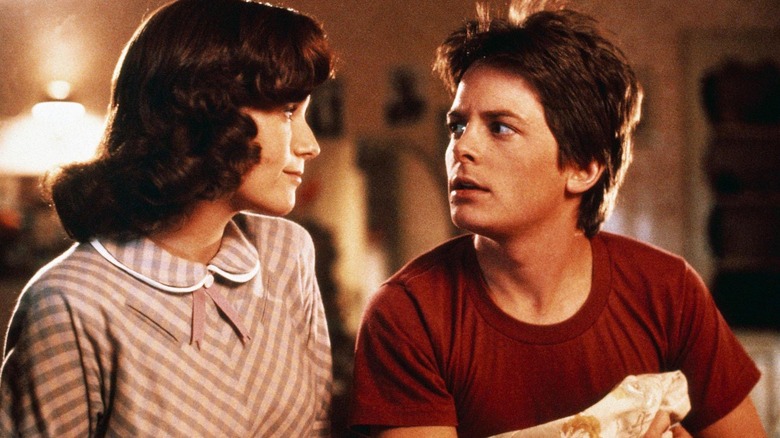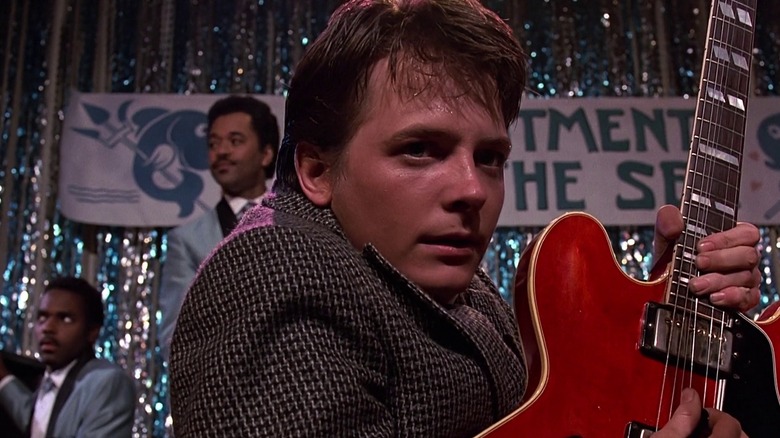40 Years Ago, Back To The Future's Epic Box Office Run Sparked An Everlasting Cinematic Legacy
(Welcome to Tales from the Box Office, our column that examines box office miracles, disasters, and everything in between, as well as what we can learn from them.)
"What we set out to do was to make a human, fun, comedic, dramatic story and the idea of time travel was going to be used just as a device to tell that story." Those are the words of director Robert Zemeckis speaking with The Signal in 1985 ahead of the release of "Back to the Future." Four decades removed, what Zemeckis set out to accomplish with his time travel picture seems quaint in light of what it became.
There are movies people love. There are movies that endure. And then there are movies that would be used as a relic of humanity to prove we existed should life as we know it end. Right up there with the likes of "Gone With the Wind" and "The Godfather" is "Back to the Future," unquestionably the greatest time travel movie ever made. But that's just the tip of the iceberg. Safe to say, Zemeckis and his co-writer Bob Gale more than accomplished their goal. They gifted humanity with one of the most roundly beloved, enduring cinematic classics of all time.
In this week's Tales from the Box Office, we're looking back at "Back to the Future" in honor of its 40th anniversary. We'll go over how the film came to be, its very difficult road to the big screen, what happened when it hit theaters, what happened in the aftermath of its release, how its legacy has grown over the years, and what lessons we can learn from it all these years later. Let's dig in, shall we?
The movie: Back to the Future
The film centers on teenager Marty McFly (Michael J. Fox) who is blasted back to 1955 in a time machine that the eccentric Doc Brown (Christopher Lloyd) built out of a DeLorean. Marty then finds himself in a time-shattering chain of events that runs the risk of erasing himself from existence unless he can ensure that his future parents wind up together. Meanwhile, the past's version of Doc Brown has to try and fix the machine to help Marty get back ... to the future!
Zemeckis and Gale had been trying to get "Back to the Future" made for a while, but they were rejected dozens of times. It didn't help that they had written some flops, such as Steven Spielberg's "1941." In any event, things changed after Zemeckis experienced a big hit with 1984's "Romancing the Stone." That's when the duo finally had the chance to get a studio on board.
Previously, Disney had passed on making "Back to the Future" because it was "too dirty," given the stuff with Marty and his mom. Other studios didn't think it was dirty enough, wanting something more like "Porky's." Eventually, they set up a deal at Universal Pictures. More specifically, Spielberg came on board as a producer. This would become the first movie made at his company, Amblin Entertainment, that wasn't directed by Spielberg personally.
Back to the Future could have been a very different movie
Any movie's existence is nothing shy of a minor miracle. The making of a timeless classic such as this is downright cosmic. "Back to the Future" nearly featured a refrigerator as the time machine, rather than the now-iconic DeLorean. The mere decision to focus on the past rather than the future was key. They also assembled a pitch-perfect cast, but it wasn't perfect at first.
The movie had Christopher Lloyd ("Taxi") as Doc Brown, Lea Thompson ("Red Dawn") as Lorraine McFly, Crispin Glover ("River's Edge") as George McFly, Claudia Wells ("Herbie, The Love Bug") as Jennifer and relative newcomer Tom Wilson as Biff. Oh and, originally, Eric Stoltz as Marty.
Rather famously, Stoltz filmed much of "Back to the Future" as the film's lead before being replaced by Fox. Ultimately, after editing the footage together, Zemeckis knew something needed to change. So, Universal agreed to recast the role and re-film much of the picture, at great expense. As for why Stoltz was fired? They needed someone more comedic. Also, there were issues behind the scenes. As Wilson explained in 2011...
"Eric got fired a couple of days before he was just going to get his head pounded in because in the scene in the cafeteria ... he was driving the heels of his hands hard into my collarbones, I mean really pushing me."
Three are near-countless stories about the production that have filled books. The broader point is, so much could have gone wrong. So much did go wrong. So much extra money was spent. The fact that "Back to the Future" made it to theaters in good shape was a monumental feat of studio filmmaking. What happened after that, nobody could have predicted.
The financial journey
Universal launched a brilliant marketing campaign for "Back to the Future," which carried a reported $19 million budget. That was no small thing at the time. Even so, between an intriguing teaser trailer, the appealing imagery, and the rising appeal of Fox, not to mention having "Steven Spielberg presents" on the posters and trailers, there was plenty for audiences to hook into here.
"Back to the Future" hit theaters on the weekend of July 5, 1985. It arrived mid-week to get in on the Fourth of July holiday and faced very little by way of direct competition. On its first weekend, it easily topped the charts with $11.1 million. Newcomers "The Emerald Forest" ($4.3 million) and the "Conan the Barbarian" spin-off "Red Sonja" ($2.2 million) were no match for Zemeckis and Gale's time travel flick.
Having Spielberg's name attached was fitting, as he'd invented the summer blockbuster just 10 years earlier with "Jaws." Now, he was producing them rather successfully. "Back to the Future" held the number one spot on the charts for 11 out of its first 12 weeks, only briefly losing to "Vacation" before taking the crown again. It didn't fall out of the top 10 until December. Such things are unthinkable in the modern era.
All told, with international grosses (and through its various re-releases), "Back to the Future" has amassed $215.6 million domestically to go with $173.2 million internationally for a grand, running total of $388.8 million. A home run by any measure in the movie business.
Back to the Future kicked off a hugely successful trilogy
Though Hollywood wasn't quite as franchise-obsessed in the mid-'80s as it is now, success on that scale still pretty much always means a sequel is going to happen, if it makes any sort of sense to do one. Viewers may recall a "To be continued..." card in "Back to the Future," but that wasn't added until the VHS release. In a 2015 interview with The Hundreds, Gale explained they truly had no idea a sequel would happen.
"We had no idea that there was ever going to be a sequel. As Bob Zemeckis often says, 'If we knew we were going to make a sequel, we never would have had Jennifer be in the car with him in the very end of the first movie.' Because when it came time for us to write the second one and figure what we were going to do – 'What're we going to do with Jennifer?'"
Even though they didn't make it easier on themselves, Zemeckis and Gale returned to write and direct "Back to the Future Part II" and "Back to the Future Part III," which were filmed back-to-back, released in November 1989 and May 1990, respectively. Both were big successes, taking in $332 million and $245 million worldwide, with $40 million production budgets each.
While the original "Back to the Future" is still widely considered to be by far the best, the trilogy as a whole is considered amongst the best trilogies ever produced. It also generated nearly $1 billion at the box office for Universal, putting Zemeckis and Gale on Hollywood's A-list. Still, this movie's influence extends so far beyond the box office, it's difficult to quantify.
Back to the Future's value extends far beyond the box office
Just because a movie is a hit doesn't mean it's going to have any sort of lasting impact. There are countless examples of movies that made lots of money that didn't have staying power. All due respect, but "Happy Feet" was a huge not, no meaningful cultural impact. The point is that becoming a box office smash alone doesn't guarantee any form of immortality in the annals of cinema history.
That's where "Back to the Future" truly shines. Not unlike "Star Wars" or "Indiana Jones," it became a true pop culture touchstone all over the globe. It became a staple theme park attraction for decades in the form of "Back to the Future: The Ride." To this day, physical and digital marketplaces are loaded with merch from the movies, from "Back to the Future Monopoly" to license plates and everything in between.
October 21, 2015 is known the world over as Back to the Future Day because that's the day Doc and Marty travel to in "Part II." There are Reddit threads dedicated to explaining the movie's time travel conundrums. Christopher Lloyd has had a massive career. He will always be Doc Brown to most people.
Even skateboarding became far more popular after the film's release. Huey Lewis' "The Power of Love" hit #1 on the Billboard charts and Alan Silvestri's soundtrack became a classic in its own right. Far and wide, even here and now four decades removed, this movie's presence looms large. It's so much more than a movie.
The lessons contained within
In the streaming era we live in now, it can be exceptionally tough to make a hit of any kind. There is, however, this desire at times to try and manufacture a culturally pervasive franchise. Just look at Netflix's "Rebel Moon" from director Zack Snyder. The movies were here today, gone tomorrow. The merch was rotting on discount shelves at Walmart.
Trying to buy cultural relevance is a fool's errand. As Zemeckis said, they just wanted to "make a human, fun, comedic, dramatic story" — make the best movie possible. Everything else? It's almost impossible to control. That "Back to the Future" became what it became was the result of tireless effort from Zemeckis, Gale, and everyone involved. They didn't go in thinking: "We're going to make a timeless classic that will lead to theme park rides." Madness that way lies.
Beyond that, there's something to be said for restraint. This franchise has never been rebooted. Zemeckis and Gale have made it crystal clear that "Back to the Future 4" will never happen, at least not while they live and breathe. Sure, you can make seven "Jurassic Park" movies, but the law of diminishing returns kicks in at some point. As it exists, this movie is special, and part of that is because it's finite.
That's partially why the "Back to the Future" trilogy still resonates today. It's untouched by greed and modern Hollywood. Restraint is, in many ways, its own form of success.





